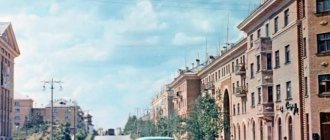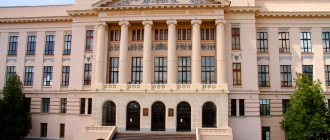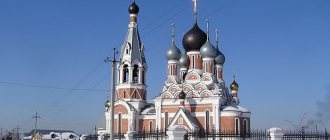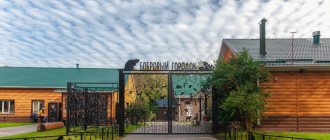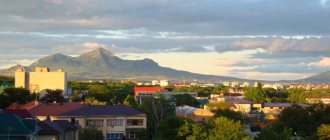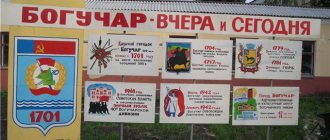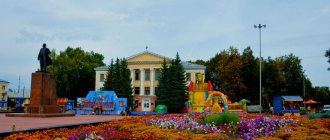| City of Ostrogozhsk, Voronezh region |
Ostrogozhsk
, a city in Russia, the administrative center of the Ostrogozhsky district of the Voronezh region, the second cathedral city of the Rossoshan diocese. Located on the Central Russian Upland, on the Tikhaya Sosna River (tributary of the Don), 3 km northwest of the railway station of the same name, 89 km south of Voronezh. Population - 33,842 (2010) [1].
- On the map: Yandex.Map, Google map
The city arose in the first quarter of the 17th century, when, on the instructions of Tsar Alexei Mikhailovich, the settlement of “Cherkasy” - Orthodox Little Russian Cossacks who fled from the Polish-Lithuanian Commonwealth from religious persecution - began along the banks of the Tikhaya Sosna River. The year of foundation of the city is considered to be 1652, when a fort was built on the Ostrogozhsky
settlement in the system of the Belgorod abatis on the southern border of the Russian state.
The prison was located at the confluence of the Ostrogoshch River with Tikhaya Sosna and was named after this river. Hydronym, in turn, was formed as a possessive adjective from the Old Russian personal name Ostrogost. The city was also colloquially called Rybny
, since the main warehouse for fish exported to the inland provinces from the Don was located here.
Cherkassy continued to move here, from which the Cherkasy regiment was formed in 1664. In 1670, a rebellion broke out in the city with the assistance of gangs of Don Cossacks, but was suppressed. In 1696, a meeting between Tsar Peter I and Mazepa took place in Ostrogozhsk. In 1708, the city was assigned to the Azov province, and in 1719 - to the Voronezh province (since 1725 - Voronezh province). In 1724, it was ordered to withdraw Russian townspeople from Ostrogozhsk to Korotoyak, and to withdraw Cherkassy Cossacks from Korotoyak to Ostrogozhsk. In 1765, Ostrogozhsk was designated a provincial town of the Sloboda-Ukrainian province; A hussar regiment was formed from the Ostrogozhsky Slobodsky Regiment, and the residents were renamed state military inhabitants. Since 1779 - a district town of the Voronezh governorship. From 1796 - again in the Sloboda-Ukrainian province, and from 1802 - in the Voronezh province.
Since 1873, the city has hosted an annual exhibition of agricultural working horses. In 1895, the Kharkov-Balashov railway passed through Ostrogozhsk. The main occupation of the residents was trade.
During the Great Patriotic War, the city was occupied by Nazi troops on July 5, 1942 and liberated on January 20, 1943. By the end of the Soviet period, food (canning, wine, butter and cheese factories, poultry processing plants) and light (shoe, clothing factories, leather factories) industries were developed in the city; car repair, brick factories, chalk-lime plant. At the beginning of the 21st century, the city partially retained the regular layout and ordinary buildings of the 19th century.
Statistics
- 1856 - 7.4 thousand inhabitants; 7 churches, 761 houses, 106 shops [2]
- January 1, 1896 - 10 stone churches and chapels, up to 500 stone and over 1000 wooden buildings; community garden and clubhouse; 4 schools, women's gymnasium; 7165 inhabitants (3319 men, 3846 women): nobles 475, clergy 93, honorary citizens and merchants 584, burghers 4691, military class 668, peasants 610, other classes 44; Orthodox 7050, schismatics 42, Roman Catholics 16, Protestants 28, Jews 18, other confessions 11 [3]
- 1913 - 23.9 thousand inhabitants [2]
- 1939 - 11.7 thousand inhabitants [2]
- 1959 - 28.4 thousand inhabitants [2]
- 1979 - 34 thousand inhabitants [2]
- 1992 - 34.9 thousand inhabitants [2]
- 2008 - 32 thousand inhabitants [2]
Religion
In the 1660s, Ostrogozhsk became part of the newly established Belgorod diocese. Since 1699 - as part of the Voronezh diocese. In 1831, as well as in 1847-1848, the city was delivered from cholera, through prayers to the Divnogorsk Icon of the Mother of God. From 1841 to 1853 there was an Ostrogozh Vicariate of the Voronezh Diocese, which was subsequently renewed in 1867-1926 and from 2011 to December 26, 2013.
Monasteries
- Pyatnitsky (female, abolished in 1788)
- Compound of the Divnogorsk Assumption Monastery (inactive)
Temples
- Alexander Nevsky, at the men's gymnasium (inactive)
- Epiphanies (invalid)
- Exaltation of the Holy Cross, cemetery (inactive)
- Michael the Archangel
- Panteleimon, Healer, prison (inactive)
- Protection of the Blessed Virgin Mary (invalid)
- Transfiguration of the Lord
- Nativity of the Blessed Virgin Mary (invalid)
- Sicilian Icon of the Mother of God, monastery (temple of the Divnogorsk metochion, inactive)
- Presentation of the Lord
- Tikhon of Zadonsk, Cathedral
- Trinity Life-Giving, Cathedral (inactive)
- Dormition of the Mother of God (Pyatnitsky) (inactive) [4]
Educational establishments
- Ostrogozhsky Theological School (inactive)
OSTROGOZHSK
OSTROGOZHSK, a city in Russia, in the west. parts of the Voronezh region, the center of the Ostrogozhsky district. Us. 33.0 thousand people (2013). Located on the river. Quiet Sosna (right tributary of the Don), 3 km from the same name. railway stations.
Founded in 1652 by voivode stolnik F. Yu. Arsenyev on the left bank of the river. Quiet Sosna as a fortress on the Belgorod border, since the same year the center of the county. The population was dominated by Cherkasy (immigrants from Ukraine). In 1652–68 the Ostrogozhsky Cherkasy regiment of Sloboda Ukraine was formed (existed until 1765). In 1670, the residents of O. supported Razin’s uprising of 1670–71: the city was taken by the rebels led by Ataman F. Kolchev. In the 2nd half. 17th century O. was part of the Belgorod category. In 1696, a meeting between Tsar Peter I and Hetman I. S. Mazepa took place in O. (a memorial sign was installed). In the beginning. 18th century the fortress was dismantled. County town of Azov (1708–1722), Kyiv (1722–27), Belgorod (1727–45), Voronezh (1745–65, 1779–97, 1802–1928), Slobodsko-Ukrainian (1765–79, 1797–1802) provinces In 1766, by decree of the Emperor. Catherine II near O. (on the left bank of the Tikhaya Sosna River) was founded by German. colony of Riebensdorf (now the village of Rybnoye). In the 2nd half. 19th century small industrial issues arose. enterprises (lard refineries, soap factories, oil mills, brick factories). In 1895, traffic opened on the railway that ran near O. line Kharkov - Balashov. Sov. power was established on October 28 (November 10), 1917. In Civil. War 1917–22 O. captured by troops of the 8th Don Cossack Division of General-L. A.K. Guselshchikova (19.9–23.11.1919). Occupied by units of the Red Army during the Southern and South-Eastern offensive fronts of 1919–20. District (since 1928) and district (1928–30) center of the Central Black Earth Region. (1928–34), from 1934 Voronezh region. In Vel. Otech. Germany was occupied during the war. and Hung. troops 5/7/1942. Liberated by units of the Red Army on January 20, 1943, during the Ostrogozh-Rossoshan offensive. operations. In 1957 in the city. The line includes the suburban settlements of Lushnikovka, Novaya Sotnya, Peski, and the nearby villages of Voloshino and Novaya Melnitsa.
Ostrogozhsk Transfiguration Church. 1764. Bell tower 1819–26. Photo by I. A. Monakov
In the old part of O., located on the left bank of the river. Quiet Sosna, the regular layout has been preserved (plan 1786) with rectangular blocks built up primarily. in the 19th century In the center (on the site of the 1652 fortress) there is a market square, Ch. the decoration of which was the Trinity Cathedral (1780–87, dismantled in the 1950s); near her, on the street. Lenin and Kramskoy Boulevard, - the Tevyashov mansions (c. 1750, after reconstruction in 1792 and 1888 - public places, then the district court; now the district administration) and the mountains. heads of Chukardin in the style of classicism (late 18th - early 19th centuries), the house of the merchant L.I. Popov (1st half of the 19th century; rebuilt in the early 1870s), etc. The building has also been preserved Church in honor of the Sicilian Icon of the Mother of God (1867–70, the dome has not been preserved; now a gymnasium) in the courtyard of the Holy Dormition Divnogorsk Monastery. (formed in the 18th century), Dyakov's house in the spirit of the neo-Renaissance (3rd quarter of the 19th century; now a medical school); Nar. a house (1900; reconstructed in the 1950s; now a cinema) and a zemstvo hospital complex (early 20th century, both in Art Nouveau style); building of the department of the Stroganov School (1909), teachers' seminary (1914), agricultural school (1930), etc. To the west of the historical. center, formerly settlement Novaya Sotnya, - baroque Spaso-Preobrazhenskaya church. type “octagon on quadrangle” (1764) with a 5-tier classic style. bell tower (1819–26); Voznesenskaya c. (1790–92; now a gym); barracks buildings in brick style (1897 - early 20th century, architect K.V. Selens) from Sretenskaya Church. (1894–96). In the former settlement Peski - c. Miracle of the Archangel Michael of the “octagon on a quadrangle” type (1775, refectory of the 3rd quarter of the 19th century, bell tower of the early 20th century); in Lushnikovka - the refectory of the Epiphany Church. (1843–59), cemetery church. St. Tikhon of Zadonsk (1868). Monument to I. N. Kramskoy, a native of O. (1987). Historical and artistic museum named after I. N. Kramskoy [since 1907; in the fire department building (1880, architect S. L. Myslovsky; the northern wing was added in 1910, architect N. I. Kramskoy; the southern wing - 1950s); rus. painting 2nd half. 19 – beginning 20 centuries], its department is the Kramskoy House Museum (opened in 1987).
Tannery, food industry enterprises, etc.
To the northeast of O., near the village of Divnogorye, is the Holy Dormition Divnogorsk men's monastery. (founded in the mid-17th century, abolished in 1786, restored in 1828, closed again in 1924, revived in 1997) with the Assumption Cathedral (1880–86, restored in the 1990s), cave churches (Nativity of John the Baptist, 1693; in honor of the Sicilian Icon of the Mother of God, 17th century).
Links[edit]
Notes[edit]
- ^ a b c d e f g h
Law No. 87-OZ - ^ a b c
Federal State Statistics Service (2011).
“All-Russian Population Census 2010. Volume 1" [All-Russian Population Census 2010, vol. 1]. All-Russian Population Census 2010 [All-Russian Population Census 2010]
. Federal State Statistics Service. - "26. The size of the permanent population of the Russian Federation by municipalities as of January 1, 2021". Federal State Statistics Service. Retrieved January 23, 2021.
- ^ a b c d e
Law No. 88-OZ - "On the Calculation of Time". Official Internet portal of legal information
. June 3, 2011. Retrieved January 19, 2021. - Post office. Information and computing center of OASU RPO. ( Post office
).
Search for postal service objects ( postal Search for objects
) (in Russian) - Federal State Statistics Service of Russia (May 21, 2004). “The population of Russia, the constituent entities of the Russian Federation as part of federal districts, urban settlements, settlements, settlements of 3 thousand or more people” [Population of Russia, its federal districts, federal districts, districts, urban settlements, rural settlements - administrative centers and rural settlements with a population of more than 3,000 people] (XLS). All-Russian Population Census 2002
. - “All-Union Population Census of 1989. The current population of union and autonomous republics, autonomous regions and districts, territories, negative phenomena, urban settlements and rural district centers” [All-Union Population Census of 1989: current population of union and autonomous republics, Autonomous regions and districts , territories, regions, districts, towns and villages performing the functions of district administrative centers. All-Union Population Census of 1989 [All-Union Population Census of 1989]
.
Institute of Demography of the National Research University: Higher School of Economics [Institute of Demography of the National Research University: Higher School of Economics]. 1989 - via Demoscope Weekly
. - “All-Union Population Census of 1979. National composition of the population by regions of Russia” [All-Union Population Census of 1979. Ethnic composition of the population by regions of Russia] (XLS). All-Union Population Census of 1979 [All-Union Population Census of 1979]
.
1979 - via Demoscope Weekly
(website of the Institute of Demography of the State University - Higher School of Economics. - ^ a b
Plokhy, Sergey, 1957-.
Cossack Myth: History and Statehood in the Age of Empires
. ISBN 1-107-44903-0. OCLC 1041371688 .CS1 maint: multiple names: authors list (link) - The Russo-Turkish War, 1768–1774: Catherine II and the Ottoman Empire
. Bloomsbury Academic. 2021 DOI: 10.5040/9781474211147. ISBN 978-1-4725-1293-2. - Davis B. Russian-Turkish War, 1768-1774: Catherine II and the Ottoman Empire. London, 2021. P. 75.
- Kollmann, Nancy: Crime and Punishment in Early Modern Russia. Cambridge, 2012. P. 377.
- “Ostrogozhsk” & hl = de & sa = X & ved = 0ahUKEwiQwOSzwr_oAhUZ5KYKHe3KA1EQ6AEIRDAD # v = onepage & q = “ostrogozhsk” & f = false Plokhy S. Cossack myth: history and nationality in the era. Cambridge, 2012. P. 21.
- ^ a b c
Leonov, I.
Ukrainian Don region
. "Young Ukraine" - "OSTROGOZK" . resource.history.org.ua
. Retrieved March 13, 2021. - ^ a b
Smoliy, V.A.
Ivan Dzykovsky (DZIKOVSKY IVAN) . Encyclopedia of Ukrainian History. - Demoscope. 1897 Census
- “Ukraine is Young:.: Vidannya | Ukrainian Podonnya". January 12, 2016 archive from the original on January 12, 2021. Retrieved June 1, 2021.
- "Ostrozhye". www.encyclopediaofukraine.com
. Retrieved March 31, 2021.
Sources [edit]
- Voronezh Regional Duma. Law No. 87-OZ of October 27, 2006 “On the administrative-territorial structure of the Voronezh region and the procedure for changing it,” as amended. Law No. 41-OZ of April 13, 2015 “On amendments to the Law of the Voronezh Region” On the administrative-territorial structure of the Voronezh Region and its amendments “”. Came into force after 10 days from the date of official publication. Published: “Young Communard”, No. 123, November 3, 2006 (Voronezh Regional Duma. Law of October 27, 2006 No. 87-OZ “ On the administrative-territorial structure of the Voronezh region and the procedure for changing it”
as amended by Law No. 41 -OZ dated April 13, 2015
On amendments to the Law of the Voronezh Region “On the administrative-territorial structure of the Voronezh Region and the procedure for its amendment"
. Valid after 10 days from the date of official publication.). - Voronezh Regional Duma. Law No. 88-OZ of December 2, 2004 “On establishing boundaries, granting the status of administrative determination to the centers of the municipalities of Gribanovsky, Kashira, Ostrogozhsky, Semiluksky, Talovsky, Khokholsky negation and the city of Novovoronezh,” as amended. Law No. 77-OZ of June 4, 2015 “On amendments to certain legislative acts of the Voronezh region in connection with changes in some municipalities of the Voronezh region.” Came into force on the date of official publication. Published: “Commune”, No. 189, December 4, 2004 (Voronezh Regional Duma. Law No. 88-OZ of December 2, 2004 On establishing boundaries, assigning the appropriate status, creating administrative centers of the municipalities of Gribanovsky, Kashirsky, Ostrogozhsky, Semiluksky , Talovsky, Khokholsky districts and the city of Novovoronezh
as amended by Law No. 77-OZ of June 4, 2015
On amendments to various legislative acts of the Voronezh region in connection with changes in the boundaries of several municipalities of the Voronezh region
... Valid from the date of official publication.).
How to get there
Ostrogozhsk is located 120 km from Voronezh. Travel time by car is 1.5-2 hours. About 20 buses depart daily from Voronezh to Ostrogozhsk from the South-Western bus station (Patriotov Avenue, 11). Travel time is 2-3 hours, the cost of a one-way ticket is from 211 to 248 rubles.
You can find a driver companion using the BlaBlaCar service, whose users daily offer dozens of options for trips from Voronezh to Ostrogozhsk. To find a travel companion, you need to register on the website, provide a phone number and email, briefly describe your interests, talk about your attitude towards smoking, music in the cabin, pets and other details that may be important on the road. Drivers can be selected based on the ratings and reviews that other users left for them. Prices for fellow travelers vary from 150 to 250 rubles per person.
What to see
Historical and Art Museum named after I.N. Kramskoy
How much: 50 rubles, free for children. Excursion service – 300 rubles for groups of 10 people or more.
When: daily from 9:00 to 18:00 except Monday and Tuesday. On Thursday from 11.00 to 19.00 without a break. Inquiries by phone: (47375) 4 14 81.
The History and Art Museum is located in a building that is more than 130 years old and is an architectural monument. It is crowned by a fire tower; from its observation deck a panoramic view of the historical center of the city opens.
Photo – Irina Ivanova
The museum’s art gallery, for which a second floor was added 107 years ago, contains a collection of paintings by Ivan Kramskoy, Vasily Polenov, Ivan Aivazovsky, Ilya Repin, Ivan Shishkin, Vladimir Makovsky.
Photo – Irina Ivanova
Unique exhibits are in the hall of numismatics, heraldry and sphragistics: treasures of coins and seals of the 18th-19th centuries, a collection of bonds from the period of the October Revolution and the Civil War.
House-Museum of Ivan Kramskoy
The future artist spent his childhood and youth in this house. The building itself is a real Little Russian hut, in which you can see ancient icons, furniture and household utensils of peasants, artisans and poor townspeople of the 18th-19th centuries and documents related to the painter’s childhood.
Photo – Irina Ivanova
Not far from the Kramskoy house-museum on Osvobozhdeniye Street there is a granite stone erected in honor of the meeting between Peter I and Hetman of Ukraine Ivan Mazepa, which took place on September 16, 1696. At this time, Peter was returning from the second, victorious Azov campaign, in which the Ostrogozh Cossacks participated. Mazepa congratulated the emperor on his victory and presented him with a saber set with gold and precious stones and a shield on a gold chain.
City Park
This is one of the main attractions of the Ostrogozhsky district, and the park gates are the calling card of the city. On Sundays at 17:00 there are dances at the fountain to the music of the brass band of military unit 20155.
Attractions, including a 29-meter Ferris wheel, start operating from 12:00 on weekends and from 16:00 on weekdays.
Korotoyak
Korotoyak was founded as a military fortress in the 17th century. In July-August 1942 and January 1943, battles took place in these territories that went down in the history of the Great Patriotic War. Here, Hero of the Soviet Union Igor Panganis, whose ancestors took part in the Battle of Borodino and the battles of the First World War, accomplished a feat. To tell guests about the military past of the village, a tourist route “To Places of Military Glory” was organized in Korotoyak. Excursions are free for groups of five to 20 people. Phone for inquiries: (47375) 3 11 94.
Mostishchensky labyrinth
On the territory of the Korotoyak rural settlement there is another attraction - an above-ground stone labyrinth near the Mastishche farm on the Potudan River. The labyrinth was built by the people of the Ivano-Bugorsk culture at the end of the third millennium BC. made of chalk stones and had a cult purpose. The structure consisted of six circular stone masonry measuring 26x38 m. It was later significantly destroyed.
Sentry
Sheer chalk slopes on the Don River near the village of Storozhevoye, ranging from 50 to 200 m in height, are an unusual sight in our region, where the steppe landscape predominates. Mountaineering competitions are held here every summer.


